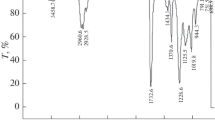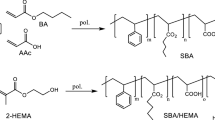Abstract
The present work describes a miniemulsion approach for the incorporation of alkoxysilanes into acrylate latex systems in order to protect the silane moieties from hydrolysis and premature crosslinking by reducing their contact with water. Vinyltriethoxysilane (VTES)/n-butyl acrylate (BA) systems were analyzed. Copolymer latexes were synthesized by miniemulsion polymerization procedures using ammonium persulfate as initiator and sodium lauryl sulfate as surfactant. Silane moieties were successfully incorporated up to 50 mol% into poly(BA) latex systems by batch miniemulsion polymerization. An oil-soluble initiator, 2,2′-azobis(2-methyl-butyronitrile) (AMBN) was also employed. Gas chromatography was employed to monitor the VTES/BA miniemulsion copolymerization reactions. Swelling studies showed that the degree of crosslinking in the resulting copolymers and the molecular mobilities of silane vinyl groups depended on the initiation system; 1>H spin-diffusion NMR experiments allowed the inference of particle morphologies that were found to depend on the reaction pH (domains for pH 5.5 and core/shell for pH 1.5). Differential scanning calorimetry (DSC) measurements and FT-IR analyses of residual OH groups in cast films were employed to evaluate the capacity of crosslinking upon film drying. Quantitative 13>C-NMR analysis found no difference in the amount of unreacted silane vinyl groups between the systems initiated by APS at pH 1.5 and AMBN at pH 5.5, respectively. The effect of the monomer hydrophobicity was studied using 2-ethylhexyl acrylate. Comparative kinetic studies (reaction calorimetry) on VTES/BA and VTES/2-ethylhexyl acrylate miniemulsion systems indicated that the silane hydrolysis is influenced by the hydrophobicity of the acrylic monomer and occurs at the droplet/water interface, the best silane protection from hydrolysis being achieved for the least hydrophobic monomer (BA).
Acknowledgement Financial support from the Emulsion Polymers Industrial Liaison Program is highly appreciated.
Preview
Unable to display preview. Download preview PDF.
Similar content being viewed by others
Author information
Authors and Affiliations
Corresponding author
Editor information
Rights and permissions
About this paper
Cite this paper
Marcu, I., Daniels, E.S., Dimonie, V.L., Roberts, J.E., El-Aasser, M.S. A miniemulsion approach to the incorporation of vinyltriethoxysilane into acrylate latexes. In: Tauer, K. (eds) Aqueous Polymer Dispersions. Progress in Colloid and Polymer Science, vol 124. Springer, Berlin, Heidelberg. https://doi.org/10.1007/978-3-540-36474-0_7
Download citation
DOI: https://doi.org/10.1007/978-3-540-36474-0_7
Published:
Publisher Name: Springer, Berlin, Heidelberg
Print ISBN: 978-3-540-00578-0
Online ISBN: 978-3-540-36474-0
eBook Packages: Springer Book Archive




